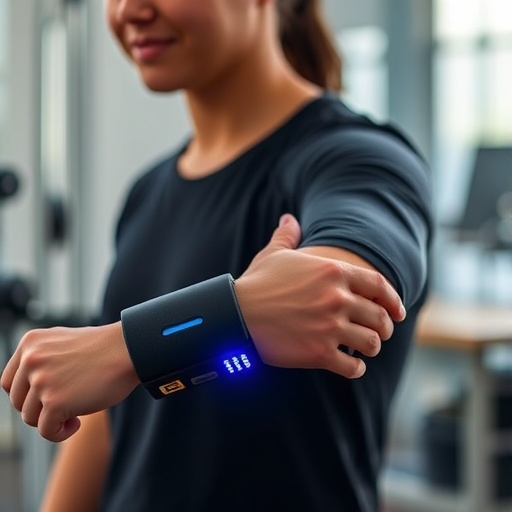In a groundbreaking leap forward for rehabilitation technology, a team of researchers has unveiled a personalized machine learning-based control system for wearable robotic devices that markedly enhances arm function in individuals with motor impairments. This innovative approach, published in Nature Communications, represents a fusion of cutting-edge artificial intelligence algorithms and biomechanical engineering to tailor robotic assistance uniquely to each user’s neuromuscular profile. The implications for patients suffering from stroke, spinal cord injuries, or other conditions that impair arm movement are profound, potentially revolutionizing both clinical therapy and long-term disability management.
Traditional wearable robotic exoskeletons have long promised to restore mobility and dexterity, but their effectiveness has often been limited by a one-size-fits-all design paradigm. Most existing systems rely on generalized control algorithms that fail to account for individual variability in muscle strength, neural control signals, and motor learning capabilities. The result is suboptimal assistance that may either under-support the user, leaving functional deficits unresolved, or over-support, which can lead to learned dependency and diminished neuroplastic recovery. The research team, led by Arnold et al., sought to overcome these fundamental challenges by developing a machine learning-based framework capable of dynamically adapting to each user’s unique physiological signals and movement intentions.
Central to the success of this system is the integration of personalized machine learning models that continuously interpret electromyographic (EMG) data collected from the wearer’s residual muscular activity. By employing an adaptive algorithm that learns from raw biosignals, the controller precisely predicts intended motion trajectories and compensates for impaired motor commands in real time. This is a significant evolution over conventional threshold-based or preprogrammed control schemes, as it allows the robot to synergistically augment voluntary movement rather than merely imposing predefined motion patterns. The result is a naturalistic extension of the wearer’s own motor capabilities, yielding not only greater functional gains but also enhanced user satisfaction and comfort.
.adsslot_AYyILBXmKC{ width:728px !important; height:90px !important; }
@media (max-width:1199px) { .adsslot_AYyILBXmKC{ width:468px !important; height:60px !important; } }
@media (max-width:767px) { .adsslot_AYyILBXmKC{ width:320px !important; height:50px !important; } }
ADVERTISEMENT
A key innovation in the work by Arnold and colleagues is the implementation of closed-loop feedback control, wherein the system monitors both the robotic actuators and the user’s bioelectric responses to continuously recalibrate assistance levels. This control architecture incorporates reinforcement learning principles, enabling the algorithm to optimize its assistance strategies through iterative interaction with the wearer. The algorithm responds to subtle variations in muscular activation patterns, fatigue, and task complexity, adjusting resistance or assistance accordingly. This adaptability is crucial for facilitating motor relearning and preventing over-reliance on the device, as it encourages the wearer’s nervous system to gradually regain autonomous control of impaired limb function.
The study employed a cohort of participants with varying degrees of hemiparesis, including individuals with chronic stroke and traumatic brain injury, to validate the efficacy of this personalized control scheme. Subjects engaged in a range of upper-limb functional tasks such as reaching, grasping, and object manipulation, with and without the wearable robot’s assistance. Quantitative assessments showed statistically significant improvements in active range of motion, grip strength, and task completion times when using the machine learning-enhanced exoskeleton, compared to baseline performance without robotic aid. Moreover, kinematic analysis revealed smoother and more coordinated movement trajectories, indicating that the control system enabled more physiologically natural motion patterns.
Importantly, the research underscores the potential neurorehabilitative benefit afforded by this technology beyond immediate functional assistance. The adaptive control paradigm appears to promote motor cortex plasticity by delivering graded resistance that challenges the user’s voluntary effort while still compensating for deficits. Early neuroimaging studies conducted in parallel with the behavioral assessments suggest increased activation and connectivity within sensorimotor networks after extended use of the personalized device. These findings support the hypothesis that the combination of real-time personalized robotic assistance and active user engagement can potentiate neural mechanisms underlying recovery, thereby facilitating sustained functional improvements even after device removal.
From an engineering perspective, the researchers overcame several formidable challenges in implementing the machine learning framework on a wearable robotic platform. The controller had to operate with stringent latency requirements to ensure seamless interaction, necessitating efficient signal processing pipelines and computational algorithms capable of rapid inference. The solution involved employing lightweight convolutional neural networks optimized for embedded hardware along with sophisticated sensor fusion techniques integrating EMG, inertial measurement units, and force sensors. The hardware-software co-design ensured robust, real-time control across a variety of dynamic movement scenarios while maintaining user safety and comfort standards.
A particularly compelling aspect of this research is the degree of personalization achieved through minimal calibration sessions. Unlike previous approaches that require extensive supervised training data collection, the adaptive algorithm demonstrated rapid convergence within minutes of initial use. This efficiency is enabled by transfer learning strategies that leverage pre-trained models on population-level data, then fine-tune control parameters based on individual user inputs. Such expediency in adaptation is critical for clinical deployment, as it minimizes setup time and user burden, making the technology more accessible to a broader patient demographic.
Notably, the authors also discuss the ethical and practical considerations inherent in deploying AI-driven assistive technologies. Ensuring user autonomy and informed consent in adaptive systems that learn and evolve over time is paramount. The study integrates transparent algorithmic logging and user override capabilities, empowering wearers with control over robotic interventions. Furthermore, the research team advocates for multidisciplinary collaboration involving clinicians, engineers, ethicists, and end-users to guide responsible innovation and equitable access to these promising technologies.
Looking ahead, the researchers emphasize the versatility of their machine learning framework for application across various wearable robotic devices targeting different limbs and even whole-body exoskeletons. The modular nature of the algorithms facilitates extension to lower extremity rehabilitation, potentially aiding gait retraining in patients with impaired locomotion. Additionally, integrating sensory feedback modalities such as haptic or proprioceptive cues could further enrich the user experience and motor learning outcomes. Ongoing trials are already underway to explore these avenues.
The convergence of personalized artificial intelligence and wearable robotics showcased in this study highlights a transformative paradigm shift in neurorehabilitation. By respecting the intrinsic variability of human motor control and learning, the technology achieves unprecedented harmony between machine and biological systems. This synergy not only restores lost function but also empowers individuals to reclaim independence and quality of life. As the field advances, such personalized, adaptive approaches are poised to become the gold standard for assistive device control.
In summary, Arnold and colleagues have delivered a compelling proof-of-concept that marries the predictive power of machine learning with the nuanced control requirements of wearable robotic rehabilitation. The demonstrated improvements in arm function, coupled with evidence for neural plasticity and user-centered design principles, place this innovation at the forefront of next-generation rehabilitative care. As AI algorithms continue to evolve and wearable technologies mature, the promise of truly personalized robotic assistance for restoring mobility and human potential is closer than ever before.
This transformative research underscores the imperative for continued investment in interdisciplinary innovation at the nexus of neuroscience, robotics, and artificial intelligence. Harnessing these emerging technologies responsibly will be critical to addressing the global burden of motor impairment and disability. The dream of restoring seamless, intuitive movement to impaired limbs through personalized robotic augmentation is rapidly becoming a reality, heralding a new era of empowered rehabilitation and enhanced human-machine symbiosis.
Subject of Research: Personalized machine learning-based control of wearable robotic exoskeletons for improving impaired arm function
Article Title: Personalized ML-based wearable robot control improves impaired arm function
Article References:
Arnold, J., Pathak, P., Jin, Y. et al. Personalized ML-based wearable robot control improves impaired arm function. Nat Commun 16, 7091 (2025). https://doi.org/10.1038/s41467-025-62538-8
Image Credits: AI Generated
Tags: artificial intelligence in rehabilitationbiomechanical engineering for rehabilitationdynamic adaptation in wearable roboticsindividualized robotic assistanceinnovative therapy for arm mobilityneuroplasticity and rehabilitationovercoming motor impairment challengespersonalized machine learning wearablerehabilitation technology for arm functionrobotic devices for motor impairmentsspinal cord injury rehabilitationstroke recovery assistive technology





